Columbia Pictures/Sony Pictures Image Movers/Amblin Entertainment (July 21, 2006), Sony Pictures Home Entertainment (October 24, 2006), single disc, 91 mins plus supplements, 2.40:1 anamorphic widescreen, Dolby Digital 5.1, Rated PG, Retail: $28.95
Storyboard:
After the owner of a mysterious neighborhood house is seemingly killed, the house’s true nature begins to be suspected by three kids. They decide to destroy the haunted house before it can harm anyone on Halloween night.
The Sweatbox Review:
Every neighborhood has one. Each community has that one neighbor that the local kids are spooked by. It is often an older man, the stereotype being that he is likely widowed and bitter. He doesn’t like kids coming onto his property, and is quick to discourage it. A legend grows up around the man, suggesting a sordid past, and various justifications for the local kids finding him creepy. And of course, the man’s house is scary, weird, different…
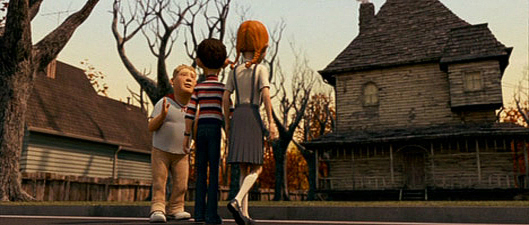
Now take the man out of the house. Is the house so scary anymore?
In Monster House, that man is Mr. Nebbercracker, robustly played by Steve Buscemi. The kids in the neighborhood know to stay clear of his place. If your ball lands on his lawn, it’s as good as gone. Don’t even think about going up to the door. D.J. knows this better than anyone. He lives across the street from Nebbercracker and has been keeping notes on all his misdeeds. A day prior to Halloween, with D.J.’s parents away at a conference, D.J. and his friend Chowder have a confrontation with Nebbercracker over a ball. That confrontation ends with an ambulance taking Nebbercracker away, but it becomes apparent that the old man was not the only dark presence on the property.
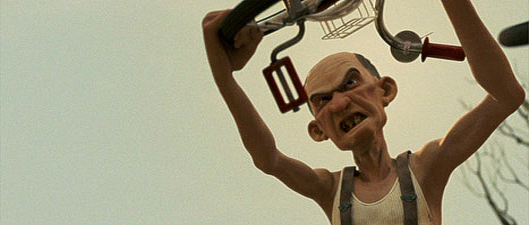
D.J. and Chowder assume that Nebbercracker is dead, but D.J. receives a call from Nebbercracker’s house that night. He and Chowder decide to stake out the house from D.J.’s bedroom, only managing to make D.J.’s babysitter, Elizabeth, think they’re nuts. Their sanity may be in question, but that doesn’t keep Elizabeth’s boyfriend from falling prey to the malevolent house. At this point, the mystical nature of the house is still in some doubt, but that doubt gets quickly erased when the boys save a neighborhood girl named Jenny from being swallowed up by the nasty building, and things only get worse when a pair of cops intervene and find themselves victims as well.
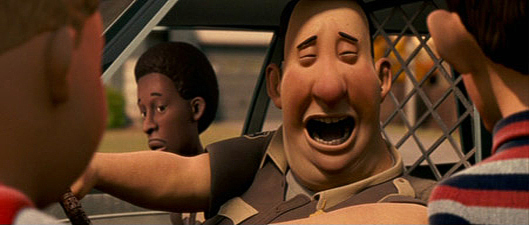
To defeat the monster house, the three kids must come up with a plan. They consult the local aging videogame star (Napoleon Dynamite himself, Jon Heder) and formulate a plan. Their attempts to “kill” the house are complicated when they learn the house’s true nature…
In a year where many have complained that all the animated films look alike in terms of characters and plot (“a group of animals leave their home and go on an adventure”), Monster House manages to be unique. Even in all the annals of theatrical features, how many animated movies have been horror-adventure-comedies? The use of the term “Animation”, however, is in some dispute. While computer technology was used to make the film, and no actors appear in the flesh onscreen, this film is a product of motion capture technology, that filmmaking tool that was used with a certain amount of criticism in The Polar Express. In both films, actors gave performances that were captured on computer files and translated into the actions of CGI cartoon characters.
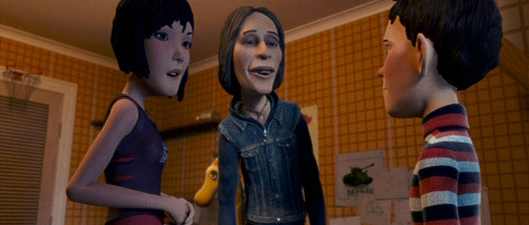
Personally, I find it hard to see the point of motion capture. It just seems to say that the producers have no faith in their animators. Executive producers Robert Zemeckis and Steven Spielberg seem to be in love with the technology, but it does have its weaknesses. Certainly, the technique does manage to bring some naturalistic movements to the screen, particularly minor flinches that actors do all the time but animators may not think to draw; but there is a trade-off. No matter how many motion capture dots one glues to an actor, it is impossible to capture the whole performance. Then, having spent so much of the budget of motion capture, there is limited chance for the animators to tweak the motion capture files to make for compelling animation. It’s not impossible to do this, but limits of time and money make it difficult; and you must have experienced motion capture animators that can pull it off— which is tough when so few of these movies have been made to date.
On the whole, Monster House succeeds maybe more than it should. Regardless of the technology, it is always difficult to do people in CGI films without making them look like puppets, so we cannot only blame the technique of motion capture. The figures actually movie quite well in the film, though the marionette problem surfaces due to decisions to not fully animate clothing or hair. When a girl jumps in real life, her hair should bounce and her clothing should ripple; but that doesn’t happen here any more than it does when one watches Reboot or Jimmy Neutron. Nevertheless, the animation (yes, I’m going to use the word) is pretty engaging at times. Doing it in straight CGI would have worked at least as well (and probably a little better, given the right animation team), but that doesn’t mean the movie doesn’t look good already.
This is helped by allowing the characters to look cartoony, which is where The Polar Express had its detractors commenting on the “uncanny valley” effect of having nearly true-to-life characters falling just creepily short of the real thing. We cut a lot more slack to cartoonish figures, even if their skin around their mouths fails to wrinkle convincingly when they smile and their irises still are often seen too fully. Too bad one can’t motion capture eyelids very well.
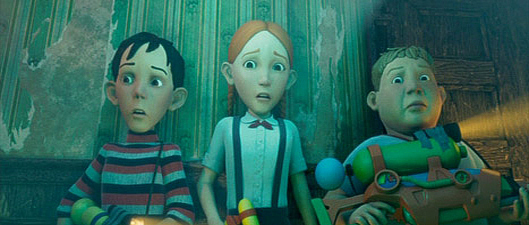
The main characters, the three kids, really sell the film. Due probably more to the child actors and good casting than the directorial or artistic skill of the people behind the camera (with all due respect), the kids come off as natural and believable. The two boys seem like buddies, and Jenny seems perfectly suited to the role of the girl who is the same age as the boys, and yet just a little ahead of them. Staging of the action is quite good as well, particularly in the exciting finale. Camera movements are active but appropriately restrained, as the filmmakers generally avoid the trap of having the virtual camera either too stationary or too busy.
The tone of the film stays fairly consistent, and this serves it well. Monster House never really goes for the cheap laughs that unfortunately characterize so many animated films, and any pop culture references are too subtle or brief to be intrusive (such as a leaf in the film’s opening that acts somewhat like the feather at the beginning of Zemeckis’ Forrest Gump). Indeed, Monster House is more reminiscent of films such as The Goonies or Stand By Me, films featuring children with lighter moments that still kept true to their stories.
All in all, Monster House is a pretty effective thriller that is suitable for most kids and their parents. This is a horror film, though, so those with younger or more sensitive children will certainly want to exercise some discretion.
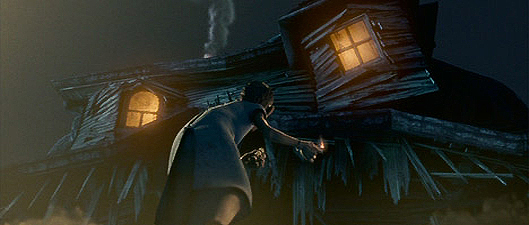
Is This Thing Loaded?
The disc opens with three Trailers, including those for Open Season, Zoom, and Spider-Man 3. From the menus, you can also find trailers for RV, The Pink Panther, and Are We There Yet?
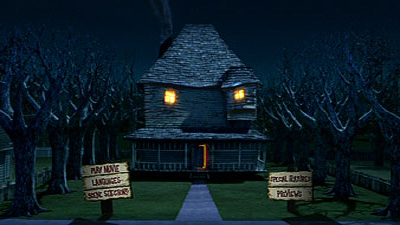
The Filmmaker Commentary is an average but enjoyable effort that is worth listening to once anyways. They discuss such things as casting, the advantages and disadvantages of motion capture filmmaking, scenes that were deleted early on, establishing and maintaining the proper tone, and such tidbits as the fact that Jon Heder’s brother was an animator on the film.
Inside Monster House (12:31 total) consists of seven featurettes that give us a behind-the-scenes look at the movie. Imaginary Heroes (3:30) looks at character design, emphasizing the cartoony look that was chosen. Beginner’s Luck discusses casting the movie. The Best Of Friends (2:41) introduces us to the three young lead actors. Lots Of Dots (2:29) takes a closer look at performance capture and dressing the actors up in their motion capture outfits. Black Box Theater (4:14) continues to look at motion capture technology. Making It Real (6:04) sees the process proceed to animation. Did You Hear That? (2:55) has the filmmakers discuss sound design. Though this falls short of being any sort of massive documentary, I found that it satisfied any desires I had to look at how the movie came together.
Evolution Of A Scene: Eliza Versus Nebbercracker first of all has a featurette (2:54) to explain the multi-angle feature that follows. Then, we see the opening of the film from the perspective of animatics, performance capture, layout, animation, the final film, or as a composite of all the versions.
Art Of Monster House contains some beautiful conceptual art and design work, including paintings and maquette.

DVD-ROM: The disc links to web-based content that offers various games and downloads.
Case Study:
Standard keepcase; current copies have a fold-out slipcase with an amusing “turning wheel” that displays, through a cut-out in the sleeve, the various stages of the house’s transformation— from “Normal” through to “Hellraising”! Always nice to see a studio try something fun with their packaging, while still allowing the package to sit comfortably on our shelves.
Ink And Paint:
The transfer, almost certainly digital-to-digital, is understandably perfect. Actually, I cannot find any fault with it. Black levels, which this film relies on so much, are thankfully rich and deep, though I have little doubt that the Blu-ray version is even better at conveying all the details. But for DVD, this is as good as it gets.
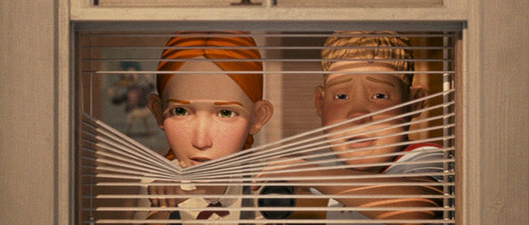
Scratch Tracks:
The soundtrack comes alive in full 5.1, bringing plenty of atmosphere to this spooky story. While the sound design is subtle in quieter passages, everything gets ramped up once the excitement begins. Nice separation effects can be found in the rear speakers when appropriate and the bass comes through with some nice moments as well.
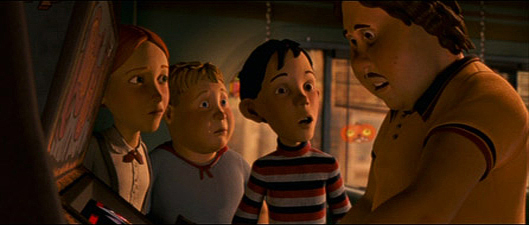
There is also a French track, as well as English and French subtitles.
Final Cut:
Monster House, dare I say it, has the feeling of a film that might be regarded as a classic once enough time has passed. It was a moderate hit in theaters, roughly making back its $75 million production cost, and seems sure to be at least as successful on home video. Nothing in the film truly dates it, and in fact it plays much like a 1980s film using 21st century technology. The filmmakers managed to craft a film that rises above its dubious (to animation fans) origins to create a fun flick that exhibits a nice balance between scares and kid-friendly fun. Video and audio on the disc are excellent, and the extras feel about right for a film of this calibre. I still don’t believe that motion capture is a necessary technology, but that doesn’t mean I can’t like the film. And… I liked it.
 | ||
 |







